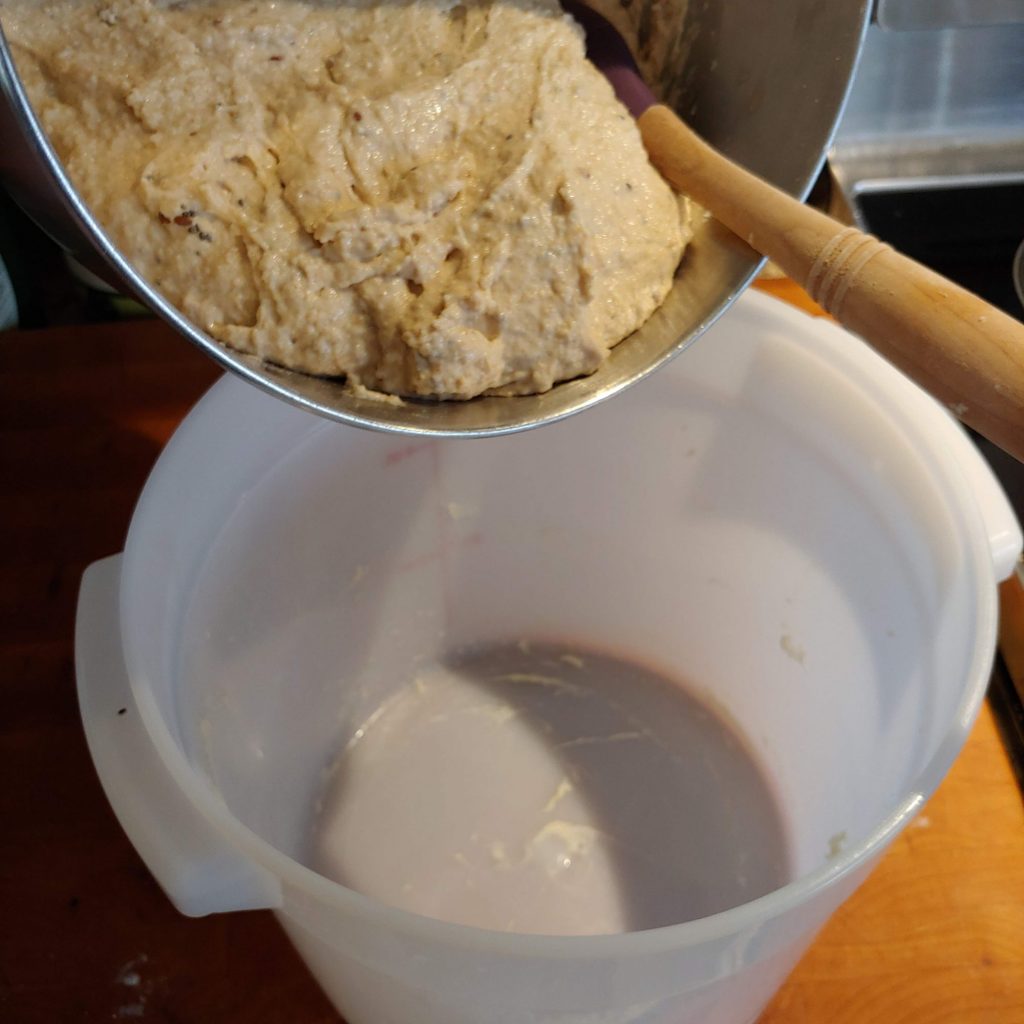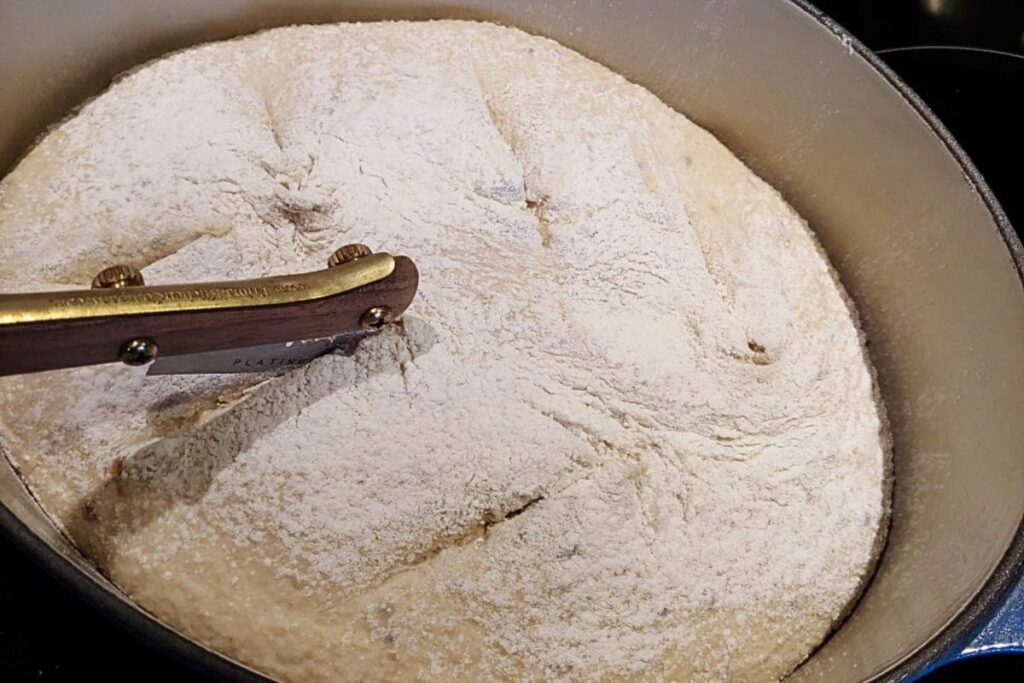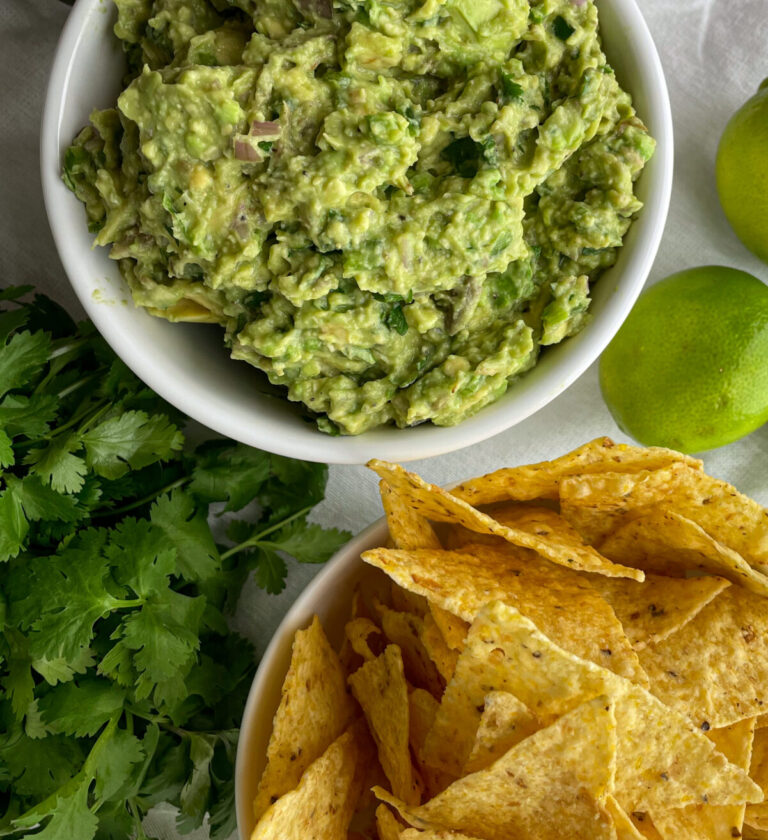This post may contain affiliate links.
No-knead bread recipes are an easy solution for making bread at home. It requires very little “hands-on” time and almost always produces a great loaf. Using simple ingredients and just a few tools, you, too, can become a bread-maker.
In addition, you’ll save a ton of money in the process, as making your own bread is much less expensive than buying it at the store.
Here’s an easy guide on making no-knead bread.

Supplies for No-Knead Bread Making
Before starting with no-knead bread-making, consider checking your kitchen to ensure you have a few helpful supplies.
- A Stand Mixer (Find it here) is the easiest way to combine the dough. It can be done by hand but will take longer and more “elbow grease.”
- A Banneton Proofing Basket (find it here) is great if you want to do free-form loaves, but you need a vessel in which they can rise. A banneton produces the cool floured ridges you see on artisan loaves.
- A Cast Iron Dutch Oven (Find it here) is a great vessel for both proofing and cooking round artisan loaves of bread. I love how they hold the bread in a great shape and, when covered, retain moisture that helps create wonderful bread.
- Basic Loaf Pans (find it here) are perfect for making sandwich bread and are a cheap alternative to fancier options.
- A Plastic Food Storage Container with Lid (find it here) is great for the first rise of your bread dough and for storing it in the fridge.
- A meat thermometer (find it here) allows you to get a quick temperature on your bread.
- A bread lame (find it here) is a fancy tool for making cuts in your bread before it goes in the oven. A sharp knife will also do the trick, but this tool can be more precise.
Ingredients
- Active Dry Yeast
- Flour
- Salt
- Optional: Maple Syrup and Honey
- Butter or Oil
- Optional: Seeds
How to Make No-Knead Bread: 5 Simple Steps
Step 1: Mix your ingredients
With lukewarm water in your mixing bowl, start by mixing the ingredients together – flour, salt, and yeast. Add maple syrup or honey for a little sweetness, butter or oil to add softness and flavor, or seeds for unique tastes and textures.

Turn the mixer on and mix for one minute. Then, add any seeds or grains halfway through.

Step 2: Let it Rise
After mixing your dough, you can leave it in the bowl or transfer it to a plastic food storage container. You’ll then place it in a warm place (we use the top of our furnace or a spot near the fireplace) for about 2 hours to rise. You want it to double in size during this first rise.

Step 3: Cool it Down (optional but recommended)
Though you can go ahead and prepare your dough for baking after the first rise, no-knead bread dough can be rather wet and loose at this point. It is much easier to work with if you transfer the dough container to the refrigerator for at least 2 hours.

And here’s the fun part – you can store dough in the fridge for up to 2 weeks while you wait to bake! This means you can double the recipe and make one loaf at a time, or you can make the dough one day and cook it another.
Step 4: Let it Rise (again)
Take your dough out of the fridge and sprinkle the top with flour. Sprinkle a working surface as well. Turn the dough onto the counter (if you are using all of it) or scoop out half if you double your recipe.

Using just a few folds and turns, gently shape your loaf into the desired shape.

A circle for a boule, a log for a loaf.
Step 5
Place the dough into your baking vessel or a banneton. Cover with a loose, clean towel.
Place your dough in a warm place to rise for about 90 minutes (less if you are making a smaller loaf or using the oven-proofing setting). You want your dough to double in size again but not get so high that it will collapse during baking.

Step 6: Bake Your Bread
Preheat your oven to the temperature recommended by your recipe, and place a roasting pan on the bottom shelf of your oven to get hot while you prep your dough to go in.
If your dough is in a banneton, you’ll flip it right onto the stone that has been preheating in the oven.
Before you close the oven door, use a sharp knife or a lame to make a few slices on top of the dough. This allows moisture to release as it bakes (without these, the bread will do it on its own and basically “burst” in a few places). You can do one slice down the middle sandwich bread style or get fancy with a few slashes here and there. They don’t need to be too deep – about 1/4 inch.

Pour about a cup of water into the roasting pan on the bottom shelf, then quickly close the door. This provides a nice, moist environment for the bread.
Set a timer according to your recipe. If you use a pan with a cover, set a timer for about half the bake time and remove the cover halfway through (this allows for a nice browning of the crust), then finish the bake.
Check your bread at the appropriate baking time (it should reach approximately 200 degrees), then remove it from the oven, cool it for about 10 minutes, and remove it from the baking vessel. For best results, bread should cool for at least an hour before you cut into it.
That’s it – you’ve made bread!

Carrie Williams Howe is an educational leader by day and an aspiring homesteader by night and weekend. She lives on a small homestead in Vermont with her husband, two children, and a rambunctious border collie. She blogs about her family's homestead life at The Happy Hive.






